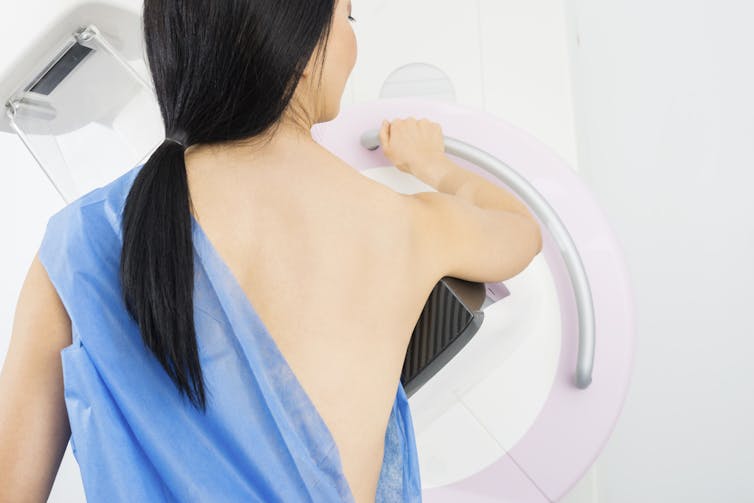when the media reports on celebrity cancer, are we really getting the whole story?
- Written by Brooke Nickel, NHMRC Emerging Leader Research Fellow, University of Sydney

Celebrity supermodel Elle Macpherson disclosed in an interview with The Australian Women’s Weekly earlier this week that seven years ago she was diagnosed with breast cancer.
Media coverage around the world said Macpherson had rejected some “conventional” treatments for the type of breast cancer she had disclosed, known as HER2-positive oestrogen receptive intraductal carcinoma.
This is not the first time we’ve seen powerful celebrity stories about cancer have the potential to influence the public health narrative. Sometimes these celebrity stories have changed cancer screening and treatment.
For instance, after singer Kylie Minogue announced her breast cancer diagnosis in 2005 there was an unprecedented increase in mammography bookings.
Actor Angelina Jolie’s op-ed in The New York Times in 2013 about her preventative double mastectomy for breast cancer may have inadvertently fuelled overtesting among women not at high risk.
And when actor Ben Stiller announced in 2016 that the prostate-specific antigen (PSA) test he had taken in his late 40s had saved his life, this was in contradiction to international screening guidelines. These recommend men under 55 do not use the PSA test because prostate cancer can often be overdiagnosed.
Should we be worried about the latest news?
Organisations, such as Breast Cancer Network Australia, have made public statements, worried that Macpherson’s comments might encourage an approach to treating invasive breast cancers that includes the use of non-evidence-based “wellness” products and interventions.
But media coverage of Macpherson’s situation has largely missed a key piece of information: her breast cancer is not invasive.
The type she disclosed is commonly known as ductal carcinoma in situ or DCIS. This is a cluster of pre-invasive or non-invasive breast cancer cells. It differs from invasive breast cancer in that the lesions are contained and have not spread. This means that treatments for invasive and non-invasive breast cancer differ.
In fact, Macpherson appears to have followed recommended treatment for her cancer. She did have surgery, a lumpectomy to remove the DCIS. Guidelines recommend patients weigh up the possible benefits and risks of the additional treatments that Macpherson said her doctor offered: mastectomy surgery, radiation, chemotherapy, and hormone therapy. Together with their treating team, each patient may decide whether any of these additional treatments are right for their individual situation.
There are ongoing research trials looking into who is most likely to benefit from these additional treatments, and who might not need them at all. Therefore, Macpherson’s decision to decline the additional treatments may have been both a reasonable and a conventional decision for a woman with non-invasive breast cancer.
This missing information from the media is also a missed opportunity to discuss less invasive options for the management of DCIS.
The rate of DCIS has increased greatly since the introduction of breast cancer screening. You can detect it on a mammogram but it rarely causes symptoms. Many of these lesions are unlikely to ever cause a problem in a woman’s lifetime. As a result of this some cases of DCIS are considered to be over-diagnosed.
Now options such as active surveillance (closely monitoring but not providing treatment unless the condition progresses) are considered reasonable and are being robustly evaluated in research trials to help reduce overtreatment.
We need to be wary of simplistic narratives about celebrity cancer journeys that don’t necessarily tell the whole story. This should also include scepticism over “wellness” narratives as these can lead to non-evidence-based treatment choices that waste consumers’ money and may cause them harm.
We all need to get better at being appropriately sceptical about health information without losing trust in proven health interventions.
I’m worried about my breast cancer. What should I do?
A breast cancer diagnosis can create a flood of different emotions, and presents a woman with many uncertainties including the effectiveness of treatments, and about their potential side effects and long-term impacts.
Women can ask their health professionals questions about possible management options, including:
what are my options? One of these options might be to choose less treatment, including an active surveillance approach for low-risk DCIS
what are the possible benefits and harms of those options?
how likely are each of those benefits and harms to happen to me?
The Conversation approached Elle Macpherson’s spokesperson to clarify details about her diagnosis and treatment but did not receive a response before publication.
Authors: Brooke Nickel, NHMRC Emerging Leader Research Fellow, University of Sydney





